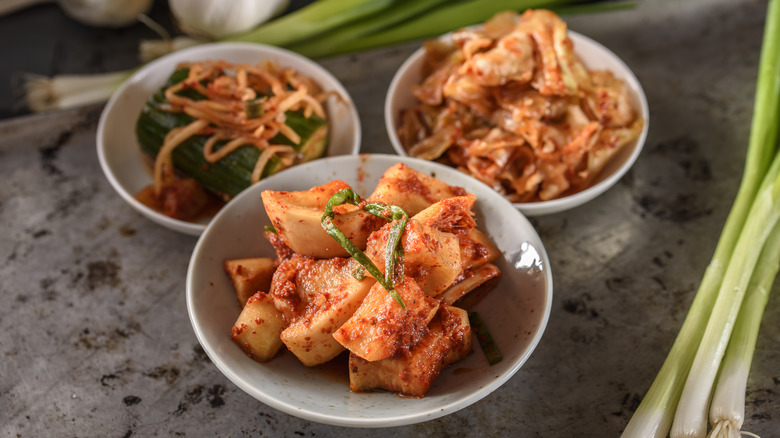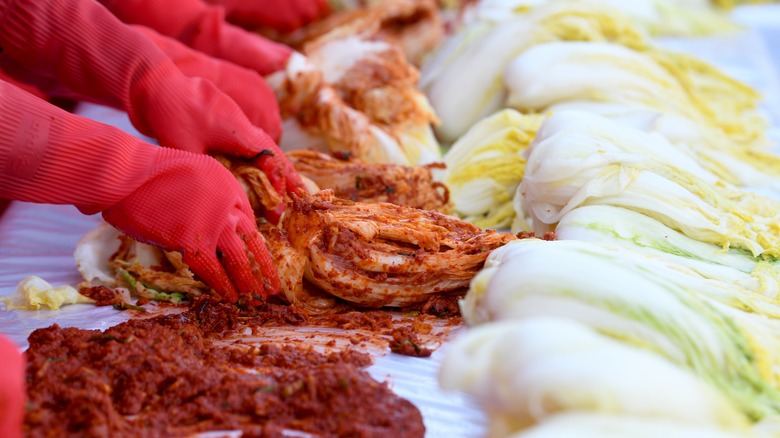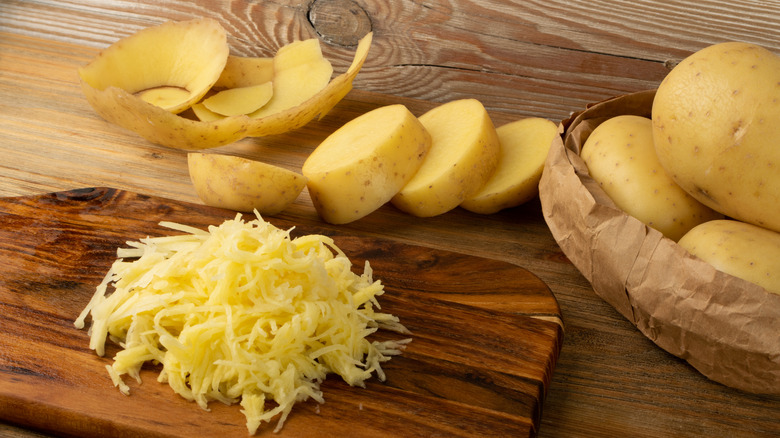The Ingredient Swap You Should Try For Better Tasting Kimchi
When it comes to secret weapon ingredients, not much can compare to kimchi. A well-made batch of kimchi is sort of a magical food. It covers multiple flavor bases, including sour, salty, spicy, and umami, not to mention it's also satisfyingly crunchy like a pickle. This spicy, fermented Korean side dish typically functions on its own or as a side dish. Kimchi can also be used in a variety of creative ways, such as to liven up a grilled cheese, top a burger, or spice up fried rice because it will add a tangy kick to almost any dish.
It's also pretty easy to make kimchi at home, as it is made of just a few ingredients that are mixed and allowed to ferment, similar to sauerkraut (although the two are not the same), or some varieties of pickles. Most traditional kimchi recipes will call for using rice flour paste, which is made by cooking rice flour with water. Rice flour is a pretty common ingredient in Korean kitchens, which is why it's traditionally used. But if you don't have any rice flour on hand, it's not a big deal because you can use a starchy potato in its place.
Kimchi hearts starch
Kimchi is typically made with Napa cabbage, but it can also be made with radishes and cucumbers, or any crunchy, hardy vegetable such as cauliflower and carrots. The fresh veggies are brined with salt to break down the cell walls of the vegetables and kill any unwanted bacteria before adding the spicy sauce, onions, and garlic, and letting fermentation take its course. For anywhere from two days to a week, the naturally occurring lactic acid bacteria found in the veggies will slowly ferment, which gives the kimchi its signature tangy, umami flavor.
Fermented foods, including kimchi, need a little bit of starch to feed the microorganisms that are doing all the work of fermenting. These organisms are living cells and they need a source of nutrients while they do their work of breaking down lactic acid, which is where starch comes in. If you've got some Napa cabbage and other ingredients for kimchi in the kitchen, but no rice flour, it's easy to use a potato instead.
The microorganisms will happily dine on potato starch, so it is okay to swap out the rice flour for any kind of potato you have in your pantry. All you have to do is peel and grate a raw potato, and briefly boil it in hot water to make a paste that should look a bit like loose mashed potatoes.
Starchy potatoes work best
Once you've made your potato paste, you can add it to your mixture of spices and garlic. A food processor or blender works great here. By grating up the potato you'll break apart all the starchy cell walls of the potato so that there's plenty available for the kimchi bacteria to consume while they do their fermenting thing.
Any kind of potato will work for fermenting a batch of kimchi, but you might want to try experimenting with different varieties to see if one works better with your preferred recipe than another. Potatoes such as russets and long whites are probably a better choice because they are starchy. Smaller, waxier potatoes like Yukon gold and fingerlings have medium to low starch levels, as well as being smaller than russets, so you'll need more than one for a batch of kimchi.
Once you get all your kimchi ingredients mixed, all you have to do is let nature take its course. Taste your kimchi every day or so to see how the fermentation is coming along, and within a couple of days, you should a batch of kimchi to serve as is or to add to recipes.


